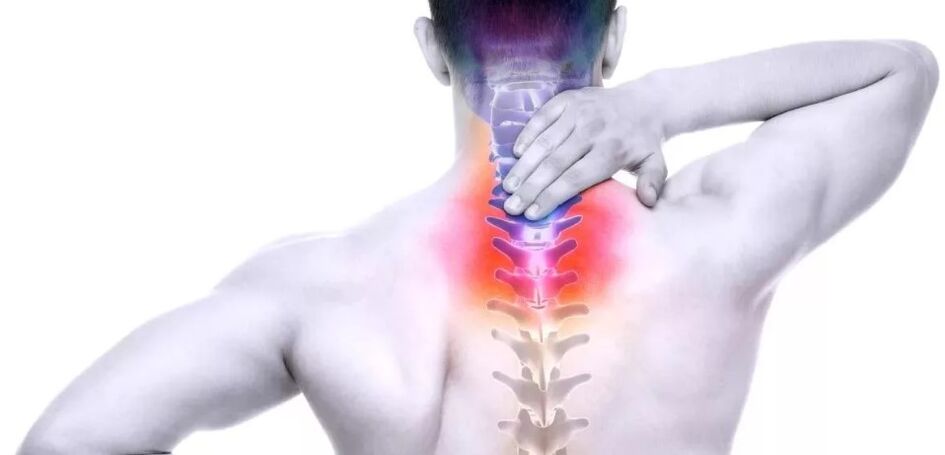Cervical osteochondrosis is the progressive dystrophic and degenerative lesion of the intervertebral discs in the area of 1-7 vertebrae belonging to the cervical region.
As a result of cervical osteochondrosis, deformity, exhaustion and then damage to the vertebrae bodies occurs. This disrupts normal blood supply and nerve conductivity in the neck and in those areas that are innervated by the roots of the nerves of the cervical nerves.
Cervical osteochondrosis can be either isolated or combined with osteochondrosis of other departments - lumbar and sacral.
The causes of dystrophic and degenerative changes in the intervertebral discs have not yet been sufficiently studied. Supposed that osteochondrosis is a senile phenomenon of confirmation. It is found even in children and adolescents.
There are a number of factors that predispose to the development of osteochondrosis. These include:
The spine, due to the characteristics of the skeleton, density, and due to the large size of the head, is particularly vulnerable to the development of osteochondrosis-the sample in it are the smallest compared to other parts of the spine, and the muscle frame is not very pronounced.
The most characteristic symptom that patients complain about - pain in the cervical region. Depending on the area of damage, the pain may be localized
The pain for cervical osteochondrosis is due to the characteristics of the cervical region.
The first signs of cervical osteochondrosis are insignificant and slightly specific:
Leading symptoms:
Vegetative-deal Because the spinal arteries are compressed, neurological manifestations are observed: headache, nausea, seizures. Spinal symptom The pain is located behind the sternum to the left. This type of pain should be distinguished from pain, as in angina (with angina, nitroglycerin is relieved by osteochondrosis - no). With a gradual violation of the structure of the intervertebral discs, their compression (compression) occurs and a disturbance of the roots of the nerves occurs, as well as narrowing or disturbance of the arteries and veins that are carried out in the area of the vertebrae bodies. This leads to the formation of special syndromes - radicular and ischemic. Circulatory disorders due to the compression of the vessels in the cervical vertebrae give a headache to migraines, severe dizziness, visual impairment and ears in the ears, flickering flies in front of the eyes, disorders of autonomous functions. There may be manifestations of cardiac syndrome with compressive heart pain, lack of air and heart rate, rhythm disorders. Serious complications of cervical osteochondrosis are In the presence of the above complaints it is necessary to appeal to the orthopedic physician or neurologist. First, the doctor will evaluate the mobility and soreness in the neck, sensitivity and other features. Radiography of the cervical spine will then be required in several projections, if necessary, computed tomography or magnetic resonance scanning with suspected hernia. In the case of bloodskets, reoencepalography and the test of the Fundus will be required. Today, there are both traditional and unconventional methods of treating osteochondrosis in the cervical spine. Conservative methods are mainly used: In the treatment of cervical osteochondrosis, substances are used to restore the structure of the intervertebral discs - chondroprototors. The course of group B vitamin therapy is shown, external therapy products are applicable - gels and ointments, creams with anti -inflammatory and analgesic components. It shows stimulants of the regeneration of the intervertebral discs. The overall massage, acupuncture, physiology, physiotherapy and gymnastics and gymnastics also surpassed the treatment of osteochondrosis. The osteopathy method has proven well - a slight effect on the "fastened" areas of the muscles and vertebrae. In the treatment of cervical osteochondrosis, it is recommended to wear a special collar (a black collar). Complications of cervical osteochondrosis with hernia, which disrupt sensitivity and blood circulation, can be treated immediately. The duration of treatment depends on the neglect of the condition, as osteochondrosis is a progressive chronic disease. Treatment can be long and preventative courses are performed for life. Proper nutrition will help relieve osteochondrosis. The basis of the health of the cervical spine is a strong and healthy back, physical activity, a comfortable bed with anatomical pillows and a mattress, proper posture and proper nutrition. It is worth avoiding neck injuries and weight lifting. It is necessary to combine prolonged sitting with rest and warm periods.
























